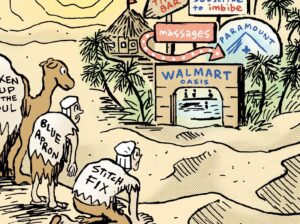CMOs To The Rescue?
Marketers have the power to enact change – they hold the purse strings. But if they cared so much, they’d do more than talk; they’d vote with their dollars.
But until that happens, they get together at industry events and talk about standards.
“Establish a unified, global standard for marketing metrics that creates alignment between marketing and financial outcomes with specific deliverables.”
That’s one of 20 proposals for the coming year submitted by a committee of 12 marketing leaders during the ANA’s Masters of Marketing show in Orlando, Florida this week, Adweek reports.
Here’s another: “Ensure that AI solutions are practical, affordable and effective for organizations of every size, driving real growth through collaboration and applied learning.”
Cute.
Meanwhile, publishers scream and stamp their feet while the ad industry takes no heed. But marketers from the Fortune 1,000 could actually change the system. They could improve online identity and privacy, shrink ad fraud, curb spend on made-for-arbitrage junk and steer the digital supply chain toward quality. Because when big brands say “get in line,” vendors snap to attention.
Instead, CMOs want to clean the river from 30,000 feet without ever leaving the airplane.
Robot Roll Call
With all the handwringing over AI disruption, it’s almost refreshing to hear about a company that’s investing in actual, physical robots instead.
Well, almost.
Internal memos leaked to The New York Times suggest that Amazon’s next big technological push will be replacing its warehouse workers with robots, potentially leading to a loss of 600,000 jobs by 2033.
According to NYT, some of the documents suggest that Amazon executives avoid using terms like “automation” and “AI” to describe these goals, a claim that the company has pushed back on.
That last detail is particularly interesting, because it implies that Amazon is all too aware of the consumer backlash against companies that have announced their automation plans in similar terms, like Duolingo and Starbucks. Heck, Amazon already faced its own white-collar mutiny earlier this year after CEO Andy Jassy sent a public memo about using AI to reduce its corporate workforce.
Of course, blue-collar workers at Amazon are far more likely to churn – at an annual turnover rate of 150%, according to a leaked memo from 2022. Yet another memo warns that the company could soon run out of new people to hire altogether.
Where This Search Leads
For marketers that rely on search traffic to drive conversions – like downloads or sales – a decline in Google Search traffic due to generative AI products is real but, somewhat surprisingly, inconsequential.
One Fortune 500 marketer tells The Information that its web traffic is down by double digits since late last year. But that decline hasn’t led to a drop in sales for its consumer products.
Mexican hotel chain Tafer is also experiencing lower web traffic, Google Search in particular, which is down by a quarter since last year. Yet bookings are still ticking up.
Clearly, some of this lost traffic must have been worthless. The rise of AI search tools simply means that people are looking for rooms in a different way, says Max Gomez Montejo, Tafer’s chief digital marketing officer.
But there is anxiety that this dynamic can’t last. Finding ways to replenish the prospecting funnel as Google Search runs dry has become a priority even if conversions haven’t dropped yet.
And what about publishers that rely directly on ad revenue generated via Google Search traffic? For them there is no silver lining.
But Wait! There’s More!
OpenAI launches ChatGPT Atlas, its AI-powered web browser. [TechCrunch]
Walmart deepens its relationship with OnePay, a one-stop finance app it helped create. [Digiday]
Warner Bros. Discovery still seems desperate to get acquired, citing offers from “multiple parties.” [Variety]
Speaking of WBD, HBO Max will raise its prices again. [TechCrunch]
What is good software architecture? [The Pragmatic Engineer]
The NFL’s promise to keep ad breaks for its RedZone subscription streaming service limited to four spots per seven hours didn’t last long. [NBC Sports]
The IAB’s NewFronts will now take place in March, months before TV upfronts week. [Adweek]
You’re Hired!
AI-powered customer engagement platform Iterable appoints Nick Beil as chief product officer and Priya Gill as CMO. [release]
















